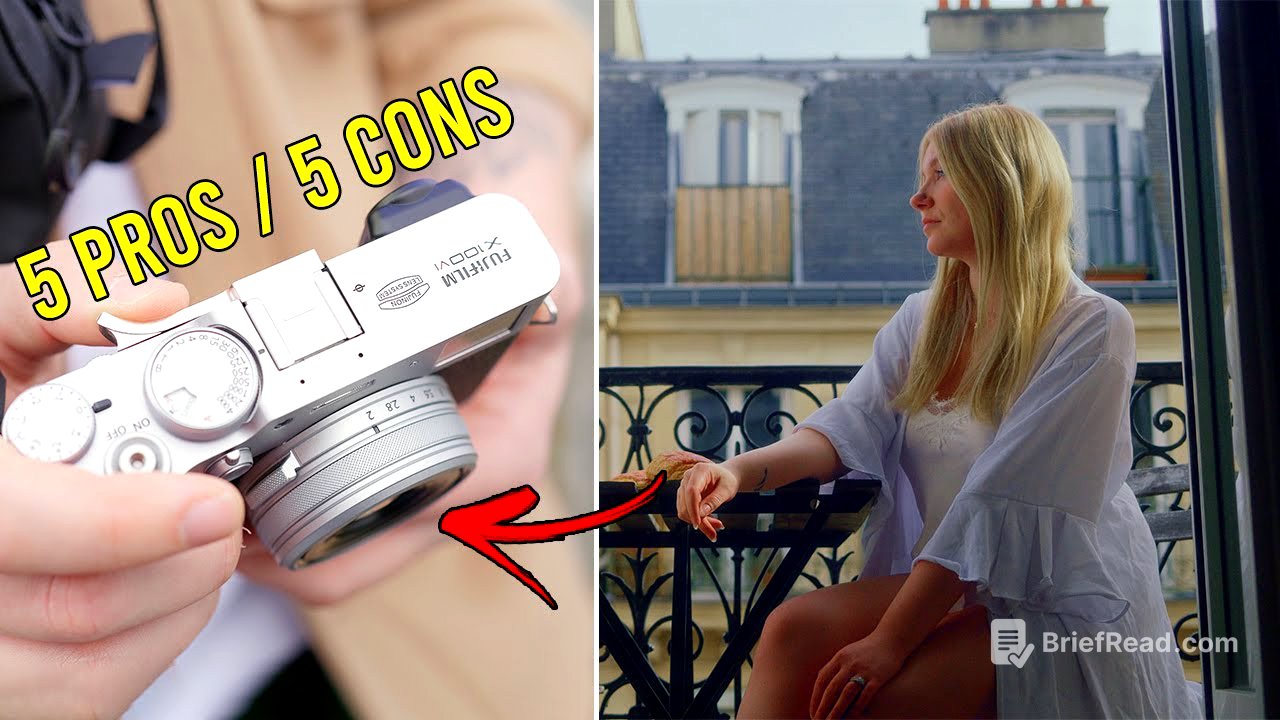TLDR;
James Reader discusses his experiences with the Fujifilm X100VI, outlining five pros and five cons after using it for about six weeks. The pros include its capabilities as a hybrid camera for both photo and video, the improved video image quality, the new film simulation "reala ace", its low light capabilities, and its aesthetics and usability. The cons include the limitations of the lens, autofocus issues, lack of improvements to the camera body, poor battery life, and slow buffer clearing.
- Great hybrid camera
- Improved video quality
- New film simulation
- Excellent low light performance
- Aesthetic and usability
Intro [0:00]
James Reader introduces a review of the Fujifilm X100VI after owning it for about six weeks. He used it as a hybrid camera for both photography and video, particularly for travel, street photography, and portraits. Instead of a typical review, he presents a list of five pros and five cons based on his experiences with the camera.
Pro 1 [0:48]
The Fujifilm X100VI is highlighted as a great hybrid camera, improving upon its predecessor, the X100V, which was primarily a photo camera due to its 8-bit video recording and clip time limits. The X100VI excels as both a photo and video camera, retaining the beloved colours and rendering of the X100V for photos, while also offering high-quality video capabilities. With the removal of recording limits, inclusion of 10-bit footage, built-in IBIS, and F-Log 2, the X100VI is a capable video camera. It is considered one of the best fixed-lens travel hybrid cameras currently available, offering very few compromises in either photo or video quality.
Pro 2 [2:55]
The video image quality of the X100VI is a significant improvement over the X100V, featuring 10-bit recording, 6K resolution, IBIS, no recording limits, and a new F-Log 2 colour profile. The footage from this camera is organic, sharp, and has improved dynamic range with a beautiful highlight roll-off. The improved video quality encourages spontaneous video capture, making it a valuable tool for travel.
Pro 3 [4:18]
The new film simulation, "reala ace," is a versatile addition, falling between classic Chrome and classic negative. It adds a subtle golden tone to scenes and landscapes while providing flattering skin tones for portraits. This simulation has become a favourite for capturing most scenes straight out of the camera. While currently exclusive to the X100VI, it could potentially be added to other Fujifilm cameras via software updates.
Pro 4 [5:11]
The X100VI demonstrates excellent low light capabilities in both photo and video modes. It performs well up to ISO 65,400 in photo mode, maintaining clean images, which is beneficial for street photographers. The inclusion of IBIS allows for lower ISO settings and longer handheld shutter speeds. In video, the camera performs impressively up to ISO 12,800, producing usable footage even at high ISOs, rivalling full-frame cameras in low light performance.
Pro 5 [6:13]
The aesthetics and usability of the Fujifilm X100VI contribute significantly to its appeal. Its design is a conversation starter and makes it enjoyable to use and accessorise. The tactile dials make shooting engaging, encouraging users to bring it along more often than larger cameras. Its compact size and capabilities for both photo and video make it ideal for situations where full-frame cameras would be left behind, allowing for the capture of spontaneous and favourite photographs.
Sponsor [7:32]
The video is sponsored by Tessan, highlighting their universal adapter designed for travellers. The adapter features multiple plug types (UK, Europe, China, Australia) and includes fast-charging USB-C and USB-A ports. It supports power conversion for US, UK, EU, and Australian plugs, making it suitable for use in airports and hotels. The adapter is available in 65W, 35W and 100W versions.
Con 1 [9:52]
The lens of the X100VI is seen as a limiting factor. It's the same lens used on the X100V, and despite the sensor's jump from 26 to 40 megapixels, there have been no optical improvements. This is considered a missed opportunity, as the expected improvements in image quality are not as significant as anticipated. The camera does not crop significantly better than the X100V, and the lens struggles in backlit situations, easily becoming washed out.
Con 2 [11:28]
The autofocus in the X100VI is described as erratic and somewhat unreliable. Despite advertised improvements, the actual number of keepers has not significantly increased. While the software side shows improvements in tracking speed and accuracy, these do not consistently translate to better end results. The autofocus is also unreliable in video, often jumping to the background or random subjects.
Con 3 [12:32]
The lack of improvements to the camera body is a missed opportunity. While the design is appreciated, certain enhancements could have been made without impacting the overall aesthetic. A quick switch for photo and video modes, similar to the one on the XT5, would have been beneficial. The absence of a d-pad and the inability to tilt the screen vertically for portrait photography are also noted as shortcomings.
Con 4 [13:49]
Battery life is a significant con, with performance being potentially worse than the X100V. Multiple batteries are needed to get through a full day of shooting. Additionally, the camera grip tends to get hot, particularly where the battery is located, which can be uncomfortable.
Con 5 [14:27]
The buffer in the X100VI is slow to clear, attributed to the larger file sizes from the higher megapixel sensor. This can be problematic when quickly switching between photo and video modes, as the camera may not allow mode changes until the buffer clears. The camera also occasionally locks up, requiring a restart, with the issue potentially linked to certain memory cards.
Bonus Con and Conclusion [15:18]
An additional con is the difficulty in acquiring the camera due to high demand. Despite its drawbacks, the X100VI remains a fun and engaging camera to use. While it may not be the revolutionary upgrade some had hoped for, it is still a great hybrid camera, particularly excelling in video image quality, making it one of the best travel cameras currently available.









